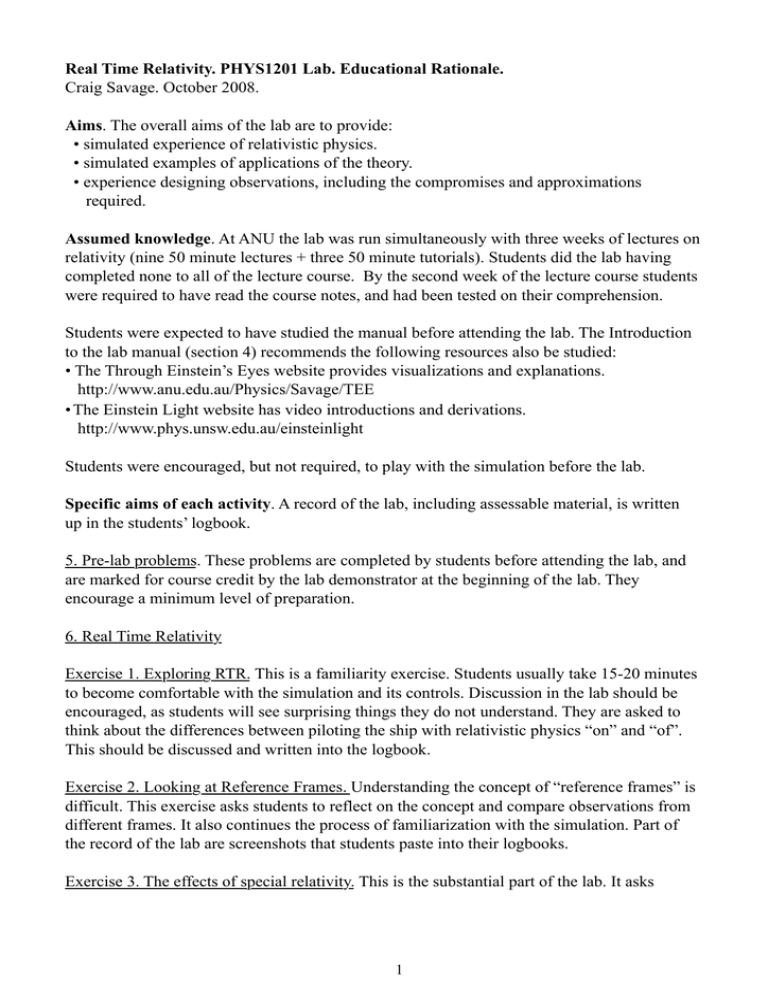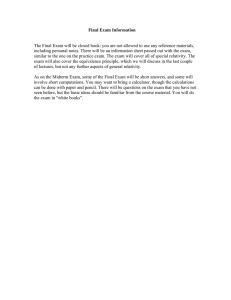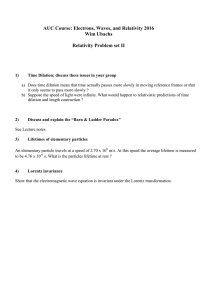Educational Rationale.rtfd
advertisement

Real Time Relativity. PHYS1201 Lab. Educational Rationale. Craig Savage. October 2008. Aims. The overall aims of the lab are to provide: • simulated experience of relativistic physics. • simulated examples of applications of the theory. • experience designing observations, including the compromises and approximations required. Assumed knowledge. At ANU the lab was run simultaneously with three weeks of lectures on relativity (nine 50 minute lectures + three 50 minute tutorials). Students did the lab having completed none to all of the lecture course. By the second week of the lecture course students were required to have read the course notes, and had been tested on their comprehension. Students were expected to have studied the manual before attending the lab. The Introduction to the lab manual (section 4) recommends the following resources also be studied: • The Through Einstein’s Eyes website provides visualizations and explanations. http://www.anu.edu.au/Physics/Savage/TEE • The Einstein Light website has video introductions and derivations. http://www.phys.unsw.edu.au/einsteinlight Students were encouraged, but not required, to play with the simulation before the lab. Specific aims of each activity. A record of the lab, including assessable material, is written up in the students’ logbook. 5. Pre-lab problems. These problems are completed by students before attending the lab, and are marked for course credit by the lab demonstrator at the beginning of the lab. They encourage a minimum level of preparation. 6. Real Time Relativity Exercise 1. Exploring RTR. This is a familiarity exercise. Students usually take 15-20 minutes to become comfortable with the simulation and its controls. Discussion in the lab should be encouraged, as students will see surprising things they do not understand. They are asked to think about the differences between piloting the ship with relativistic physics “on” and “of”. This should be discussed and written into the logbook. Exercise 2. Looking at Reference Frames. Understanding the concept of “reference frames” is difficult. This exercise asks students to reflect on the concept and compare observations from different frames. It also continues the process of familiarization with the simulation. Part of the record of the lab are screenshots that students paste into their logbooks. Exercise 3. The effects of special relativity. This is the substantial part of the lab. It asks 1 students to make observations demonstrating the physics of special relativity. Students are required to find and describe examples of specific theoretical effects. Observations are only required to be approximately quantified; e.g. length contraction was observed to be about a factor of two at v/c = 0.87. 1 & 2. Headlight and Doppler effects. These effects are simple to observe. Different levels of answer can be requested covering the effect of speed and observation direction. 3. Light Delay. This requires the use of a scenario with a clock. Understanding light delay is critical for understanding all temporal aspects of the simulation. 4 & 5. Aberration, Terrell rotation. These exercises assume students have studied aberration. If they have not, they should be referred to the lecture notes or the relevant tutorials on the Through Einstein’s Eyes web site, during the lab. For aberration, simple observations of the change in apparent position of a point with acceleration are sufficient. This is what leads to objects ahead appearing to recede when you accelerate. 6. Distortion of objects. This requires a more complex analysis of the differential changes over the extent of an object. The explanation provided is in terms of light delay rather than aberration. This is appropriate in the observer’s rest frame. Aberration is the appropriate explanation for transforming from the object’s rest frame to the observer’s rest frame. 7. Length contraction. This is open ended and demonstrator guidance will be required for most groups; preferably by asking the groups questions. Length contraction is seen when the distance from the observer to the two ends of the object are equal. Trigonometry is used to change its angular size to a length. 8. Time dilation. This requires the use of a scenario with a clock. The difficulty here is taking light delay into account. An “observational design” that is good enough, but not perfect, is required. For example, by observing a clock around the point of closest approach, but at a large enough distance that the clock’s distance does not change much over the time it is observed. Light delay is then approximately constant over the observation period. 9. The relativity of simultaneity. This requires the use of a scenario with multiple clocks. Light delay must be controlled for, as in the time dilation exercise. Exercise 4. Verifying time dilation. For most groups the previous work will require the full three hours, especially if they are are encouraged to have lively discussions. However, for students who finish early, this exercise extends the earlier work on time dilation to be fully quantitative. The Racing Course revisited. This provides an opportunity for students to have a bit of fun using the skills they have acquired operating the simulation. 2

